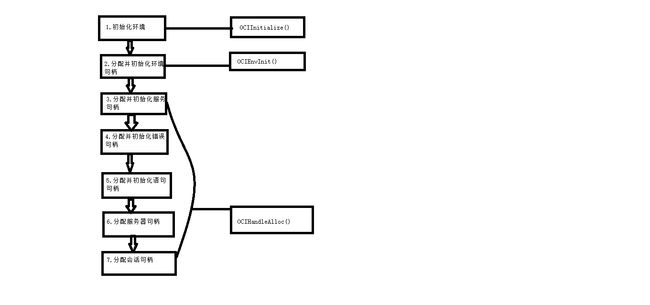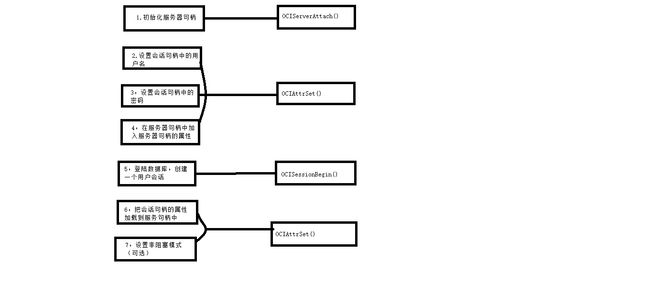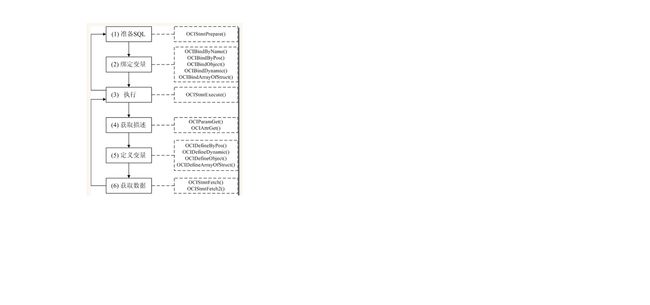C语言与OCI一起操作oracle
一,oci简介:
OCI(Oracle Call Intedace,即0racle调用层接口)是Oracle公司提供的由头文件和库函数等组成的一个访问Oracle数据库的应用程序编程接口(application programming interface API),它允许开发人员在第三代编程语言(包括C, C++, COBOL 与 FORTRAN)中通过SQL(Structure Query Language)来操纵Oracle数据库,而且OCI在一定程度上支持第三代编程语言(诸如C, C++, COBOL 与 FORTRAN)的数据类型、语法等等。OCI的显著特点是全面支持Oracle的面向对象技术,同时OCI还具有如下的一些特点:
1)高度控制应用程序的执行;
2)允许开发人员应用已熟悉的第三代程序设计语言来应用OCI;
3)可以内嵌到C代码中
4)支持动态SQL;
5)几乎所有的Oracle的开发工具都支持OCI;
6)通过回调技术(callbacks)来实现动态绑定与定义;
7)通过OCI的描述函数可以获取Oracle数据库的各种参数;
8)增强了数组在DML(data manipulation language)语言中的应用;
OCI接口支持Windows NT和Windows 95/98/2000/XP操作系统,它所支持的C语言编译器包括Borland C++和MiroSoft VisualC++等。在使用0CI开发Oralce数据库应用程序之前,应首先安装这些操作系统和C语言编译工具。在选择安装OCI开发工具包后,Oracle安装程序将0CI文件拷贝到oracle主目录内的以下子目录中:
头文件oci.h在
/home/oracle_11/app/oracle/product/11.2.0/db_1/rdbms/public/oci.h
二,简单的说一下oci的工作步骤
oci编程所需要的一些数据
typedef struct
{
OCIEnv* phOCIEnv ;//OCI环境句柄
OCIError* phOCIErr;//OCI错误句柄
OCISvcCtx* phOCISvctx;//服务上下文句柄
OCIServer* phOCIServe; /服务器上下文句柄/
OCIStmt* phOCIstmt; //语句句柄
OCISession * phSession; //会话句柄
char* DBName;//数据库服务名
char* UserName;//数据库用户名
char* Pwd;//数据库密码
}OCIHP;
2.1,分配和初始化一些句柄(如图)

2.2,分配初始化好句柄以后进行连接数据库如图

2.3,连接数据库以后就要执行一些sql语句,步骤如下
数据库连接好后可以执行SQL语句:一条SQL语句在OCI应用程序中的执行步骤一般如下:(1)准备SQL语句。(2)在SQL语句中绑定需要输入到SQL语句中的变量。(3)执行SQL语句。(4)获取SQL中的输出描述。(5)定义输出变量。(6)获取数据。具体过程及过程中调用的函数如下图所示。对于SQL中的定义语句(如CREATE,DROP)和控制语句(如GRANT,REVOKE),由于没有数据的输入输出,只需要图2中第一步和第三步即可。操作语句(如INSERT,DELETE,UPDATE)则需要执行前三步。而查询语句(如SELECT)不仅可能有数据输入,而且也有数据的输出,因此需要执行六个步骤。

三,常用函数解析可以到这里下载
http://download.csdn.net/detail/u011573853/9328969
四,案例,本人写了一个很浅显的案例,实现了增删改查操作,使用绑定参数和不绑定两种方式完成的,适合我这样的新手看,高手飘过核心代码如下
全部代码可以到此下载
http://download.csdn.net/detail/u011573853/9328997
//插入数据(不绑定参数的)
void Oci_insert(OCIHP* ph,char *sql)
{
printf("sql =%s\n",sql);
char sErrorMsg[1024];
sb4 sb4ErrorCode;
ub4 ub4RecordNo = 1;
int nRet = 0;
//准备SQL语句
nRet= OCIStmtPrepare(ph->phOCIstmt, ph->phOCIErr, (text*)sql, (ub4) strlen(sql), (ub4)OCI_NTV_SYNTAX, (ub4)OCI_DEFAULT);
if(nRet)
{
printf("%s\n","准备SQL语句错误");
printf("OCIStmtPrepare() error:%d\n",nRet);
return ;
}
printf("%s\n","kaishi执行SQL语句");
nRet = OCIStmtExecute( ph->phOCISvctx, ph->phOCIstmt, ph->phOCIErr, (ub4)1, (ub4)0, (OCISnapshot *) NULL,(OCISnapshot *) NULL, (ub4) OCI_DEFAULT); //执行SQL语句
if(nRet)
{
printf("%s\n","执行SQL语句错误");
printf("OCIStmtExecute() error:%d\n",nRet);
//获取错误信息
if (OCIErrorGet(ph->phOCIErr, ub4RecordNo++, NULL, &sb4ErrorCode, (OraText*) sErrorMsg,
sizeof(sErrorMsg), OCI_HTYPE_ERROR) == OCI_SUCCESS)
printf("error msg:%s\n", sErrorMsg);
return ;
}
printf("%s\n","执行SQL语句 OK");
Oci_commit( ph);
return ;
}
//绑定参数插入
void Oci_insert_bang(OCIHP* ph)
{
char sErrorMsg[1024];
sb4 sb4ErrorCode;
ub4 ub4RecordNo = 1;
int nRet = 0;
OCIBind* bhp[10];
char id[5]="11";
char sname[15]="liuyupei";
int age=20;
char sex[]="v";
char sql[]="insert into stu(id,sname,age,sex) values(:Vhid,:Vhname,:Vhage,:Vhsex)";
//准备SQL语句
nRet= OCIStmtPrepare(ph->phOCIstmt, ph->phOCIErr, (text*)sql, (ub4) strlen(sql), (ub4)OCI_NTV_SYNTAX, (ub4)OCI_DEFAULT);
if(nRet)
{
printf("%s\n","准备SQL语句错误");
printf("OCIStmtPrepare() error:%d\n",nRet);
return ;
}
//绑定输入参数变量
/*
//把id 和:Vhid绑定在一起
if ((nRet= OCIBindByName(ph->phOCIstmt, &bhp[0], ph->phOCIErr, (text *) ":Vhid",strlen(":Vhid"), (ub1 *)id , strlen(id)+1,
SQLT_STR, (void *) 0,(ub2 *) 0, (ub2) 0, (ub4) 0, (ub4 *) 0, OCI_DEFAULT))!=OCI_SUCCESS)
{
printf("%s\n","1参数绑定失败");
return ;
}
//把sname 和:Vhname绑定在一起
if ((nRet= OCIBindByName(ph->phOCIstmt, &bhp[1], ph->phOCIErr, (text *) ":Vhname",strlen(":Vhname"), (ub1 *)sname , strlen(sname)+1,
SQLT_STR, (void *) 0,(ub2 *) 0, (ub2) 0, (ub4) 0, (ub4 *) 0, OCI_DEFAULT))!=OCI_SUCCESS)
{
printf("%s\n","2参数绑定失败");
return ;
}
//把age 和:Vhage绑定在一起
if ((nRet= OCIBindByName(ph->phOCIstmt, &bhp[2], ph->phOCIErr, (text *) ":Vhage",-1, (ub1 *)&age , (sword)4,
SQLT_INT, (void *) 0,(ub2 *) 0, (ub2) 0, (ub4) 0, (ub4 *) 0, OCI_DEFAULT))!=OCI_SUCCESS)
{
printf("%s\n","3参数绑定失败");
return ;
}
//把sex 和:Vhsex绑定在一起
if ((nRet= OCIBindByName(ph->phOCIstmt, &bhp[3], ph->phOCIErr, (text *) ":Vhsex",strlen(":Vhsex"), (ub1 *)sex , strlen(sex)+1,
SQLT_STR, (void *) 0,(ub2 *) 0, (ub2) 0, (ub4) 0, (ub4 *) 0, OCI_DEFAULT))!=OCI_SUCCESS)
{
printf("%s\n","4参数绑定失败");
return ;
}*/
//第二种绑定的方法
OCIBindByPos(ph->phOCIstmt, &bhp[0], ph->phOCIErr, 1,
(dvoid *)id, sizeof(id), SQLT_STR,(dvoid*)0,(ub2 *) 0, (ub2) 0, (ub4) 0, (ub4 *) 0,OCI_DEFAULT);
OCIBindByPos(ph->phOCIstmt, &bhp[1], ph->phOCIErr, 2,
(dvoid *)sname, sizeof(sname), SQLT_STR,(dvoid*)0,(ub2 *) 0, (ub2) 0, (ub4) 0, (ub4 *) 0, OCI_DEFAULT);
OCIBindByPos(ph->phOCIstmt, &bhp[2], ph->phOCIErr, 3,
(dvoid *)&age, sizeof(int), SQLT_INT,(dvoid*)0,(ub2 *) 0, (ub2) 0, (ub4) 0, (ub4 *) 0, OCI_DEFAULT);
OCIBindByPos(ph->phOCIstmt, &bhp[3], ph->phOCIErr, 4,
(dvoid *)sex, sizeof(sex), SQLT_STR, (dvoid*)0,(ub2 *) 0, (ub2) 0, (ub4) 0, (ub4 *) 0, OCI_DEFAULT);
printf("%s\n","kaishi执行SQL语句");
nRet = OCIStmtExecute( ph->phOCISvctx, ph->phOCIstmt, ph->phOCIErr, (ub4)1, (ub4)0, (OCISnapshot *) NULL,(OCISnapshot *) NULL, (ub4) OCI_DEFAULT); //执行SQL语句
if(nRet)
{
printf("%s\n","执行SQL语句错误");
printf("OCIStmtExecute() error:%d\n",nRet);
//获取错误信息
if (OCIErrorGet(ph->phOCIErr, ub4RecordNo++, NULL, &sb4ErrorCode, (OraText*) sErrorMsg,
sizeof(sErrorMsg), OCI_HTYPE_ERROR) == OCI_SUCCESS)
printf("error msg:%s\n", sErrorMsg);
return ;
}
printf("%s\n","执行SQL语句 OK");
Oci_commit( ph);
return ;
}
//更新数据不绑定
void Oci_update(OCIHP* ph,char *sql)
{
printf("sql =%s\n",sql);
char sErrorMsg[1024];
sb4 sb4ErrorCode;
ub4 ub4RecordNo = 1;
int nRet = 0;
//准备SQL语句
nRet= OCIStmtPrepare(ph->phOCIstmt, ph->phOCIErr, (text*)sql, (ub4) strlen(sql), (ub4)OCI_NTV_SYNTAX, (ub4)OCI_DEFAULT);
if(nRet)
{
printf("%s\n","准备SQL语句错误");
printf("OCIStmtPrepare() error:%d\n",nRet);
if (OCIErrorGet(ph->phOCIErr, ub4RecordNo++, NULL, &sb4ErrorCode, (OraText*) sErrorMsg,
sizeof(sErrorMsg), OCI_HTYPE_ERROR) == OCI_SUCCESS)
printf("error msg:%s\n", sErrorMsg);
return ;
}
printf("%s\n","kaishi执行SQL语句");
nRet = OCIStmtExecute( ph->phOCISvctx, ph->phOCIstmt, ph->phOCIErr, (ub4)1, (ub4)0, (OCISnapshot *) NULL,(OCISnapshot *) NULL, (ub4) OCI_DEFAULT); //执行SQL语句
if(nRet)
{
printf("%s\n","执行SQL语句错误");
printf("OCIStmtExecute() error:%d\n",nRet);
//获取错误信息
if (OCIErrorGet(ph->phOCIErr, ub4RecordNo++, NULL, &sb4ErrorCode, (OraText*) sErrorMsg,
sizeof(sErrorMsg), OCI_HTYPE_ERROR) == OCI_SUCCESS)
printf("error msg:%s\n", sErrorMsg);
return ;
}
printf("%s\n","执行SQL语句 OK");
Oci_commit( ph);
return ;
}
//更新数据绑定参数
void Oci_update_bang(OCIHP* ph)
{
char sErrorMsg[1024];
sb4 sb4ErrorCode;
ub4 ub4RecordNo = 1;
int nRet = 0;
OCIBind* bhp[10];
char id[5]="11";
char sname[15]="liweieieieei";
;
char sql[]="update stu set sname=':Vhname' where id=':Vhid'";
//准备SQL语句
nRet= OCIStmtPrepare(ph->phOCIstmt, ph->phOCIErr, (text*)sql, (ub4) strlen(sql), (ub4)OCI_NTV_SYNTAX, (ub4)OCI_DEFAULT);
if(nRet)
{
printf("%s\n","准备SQL语句错误");
printf("OCIStmtPrepare() error:%d\n",nRet);
return ;
}
//绑定输入参数变量
/*
//把id 和:Vhid绑定在一起
if ((nRet= OCIBindByName(ph->phOCIstmt, &bhp[0], ph->phOCIErr, (text *) ":Vhid",strlen(":Vhid"), (ub1 *)id , strlen(id)+1,
SQLT_STR, (void *) 0,(ub2 *) 0, (ub2) 0, (ub4) 0, (ub4 *) 0, OCI_DEFAULT))!=OCI_SUCCESS)
{
printf("%s\n","1参数绑定失败");
return 0;
}
//把sname 和:Vhname绑定在一起
if ((nRet= OCIBindByName(ph->phOCIstmt, &bhp[1], ph->phOCIErr, (text *) ":Vhname",strlen(":Vhname"), (ub1 *)sname , strlen(sname)+1,
SQLT_STR, (void *) 0,(ub2 *) 0, (ub2) 0, (ub4) 0, (ub4 *) 0, OCI_DEFAULT))!=OCI_SUCCESS)
{
printf("%s\n","2参数绑定失败");
return 0;
}
*/
//第二种绑定的方法
OCIBindByPos(ph->phOCIstmt, &bhp[0], ph->phOCIErr, 2,
(dvoid *)id, sizeof(id), SQLT_STR,(dvoid*)0,(ub2 *) 0, (ub2) 0, (ub4) 0, (ub4 *) 0,OCI_DEFAULT);
OCIBindByPos(ph->phOCIstmt, &bhp[1], ph->phOCIErr, 1,
(dvoid *)sname, sizeof(sname), SQLT_STR,(dvoid*)0,(ub2 *) 0, (ub2) 0, (ub4) 0, (ub4 *) 0, OCI_DEFAULT);
printf("%s\n","kaishi执行SQL语句");
nRet = OCIStmtExecute( ph->phOCISvctx, ph->phOCIstmt, ph->phOCIErr, (ub4)1, (ub4)0, (OCISnapshot *) NULL,(OCISnapshot *) NULL, (ub4) OCI_DEFAULT); //执行SQL语句
if(nRet)
{
printf("%s\n","执行SQL语句错误");
printf("OCIStmtExecute() error:%d\n",nRet);
//获取错误信息
if (OCIErrorGet(ph->phOCIErr, ub4RecordNo++, NULL, &sb4ErrorCode, (OraText*) sErrorMsg,
sizeof(sErrorMsg), OCI_HTYPE_ERROR) == OCI_SUCCESS)
printf("error msg:%s\n", sErrorMsg);
return ;
}
printf("%s\n","执行SQL语句 OK");
Oci_commit( ph);
return ;
}
//查询
void Oci_select(OCIHP* ph)
{
int nRet = 0;
ub4 ub4RecordNo = 1;
OCIDefine * bhp[10];
char id[20];
char sname[30];
int age;
char sex[20];
char sErrorMsg[1024];
sb4 sb4ErrorCode;
//char sname[10] ={0};
b2 sb2aIndid[30]; //指示器变量,用于取可能存在空值的字
char sql[]="select id,sname,age,sex from stu ";
nRet= OCIStmtPrepare(ph->phOCIstmt, ph->phOCIErr, (text*)sql,
(ub4) strlen(sql), (ub4)OCI_NTV_SYNTAX, (ub4)OCI_DEFAULT); //准备SQL语句
if(nRet)
{
printf("%s\n","准备SQL语句错误");
printf("OCIStmtPrepare() error:%d\n",nRet);
return ;
}
//获取数据长度
ub2 datalen = 0;
//绑定输出参数
if(OCIDefineByPos(ph->phOCIstmt,&bhp[0],ph->phOCIErr, 1, (dvoid *)&id, (ub4)sizeof(id),
SQLT_STR/*LBI long binary type */, &sb2aIndid[0], &datalen, NULL, OCI_DEFAULT) !=0)
{
//获取错误信息
if (OCIErrorGet(ph->phOCIErr, ub4RecordNo++, NULL, &sb4ErrorCode, (OraText*) sErrorMsg,
sizeof(sErrorMsg), OCI_HTYPE_ERROR) == OCI_SUCCESS)
printf("error msg:%s\n", sErrorMsg);
OCIHandleFree(ph->phOCIstmt, OCI_HTYPE_STMT);
printf("%s\n","1参数绑定失败");
return ;
}
if(OCIDefineByPos(ph->phOCIstmt,&bhp[1],ph->phOCIErr, 2,(dvoid *)&sname, (ub4)sizeof(sname),
SQLT_STR/*LBI long binary type */, &sb2aIndid[1], &datalen, NULL, OCI_DEFAULT) !=0)
{
//获取错误信息
if (OCIErrorGet(ph->phOCIErr, ub4RecordNo++, NULL, &sb4ErrorCode, (OraText*)sErrorMsg,
sizeof(sErrorMsg), OCI_HTYPE_ERROR) == OCI_SUCCESS)
printf("error msg:%s\n", sErrorMsg);
OCIHandleFree(ph->phOCIstmt, OCI_HTYPE_STMT);
printf("%s\n","2参数绑定失败");
return ;
}
if(OCIDefineByPos(ph->phOCIstmt,&bhp[2],ph->phOCIErr, 3,(dvoid *)&age, (ub4)4,
SQLT_INT/*LBI long binary type */, NULL, &datalen, NULL, OCI_DEFAULT) !=0)
{
//获取错误信息
if (OCIErrorGet(ph->phOCIErr, ub4RecordNo++, NULL, &sb4ErrorCode, (OraText*) sErrorMsg,
sizeof(sErrorMsg), OCI_HTYPE_ERROR) == OCI_SUCCESS)
printf("error msg:%s\n", sErrorMsg);
OCIHandleFree(ph->phOCIstmt, OCI_HTYPE_STMT);
printf("%s\n","3参数绑定失败");
return ;
}
if(OCIDefineByPos(ph->phOCIstmt,&bhp[3],ph->phOCIErr, 4,(dvoid *)&sex, (ub4)sizeof(sex),
SQLT_STR/*LBI long binary type */, &sb2aIndid[3], &datalen, NULL, OCI_DEFAULT) !=0)
{
//获取错误信息
if (OCIErrorGet(ph->phOCIErr, ub4RecordNo++, NULL, &sb4ErrorCode, (OraText*)sErrorMsg,
sizeof(sErrorMsg), OCI_HTYPE_ERROR) == OCI_SUCCESS)
printf("error msg:%s\n", sErrorMsg);
OCIHandleFree(ph->phOCIstmt, OCI_HTYPE_STMT);
printf("%s\n","4参数绑定失败");
return ;
}
//获取执行语句类型
ub2 stmt_type;
OCIAttrGet ((dvoid *)ph->phOCIstmt, (ub4)OCI_HTYPE_STMT, (dvoid *)&stmt_type, (ub4 *)0, (ub4)OCI_ATTR_STMT_TYPE, ph->phOCIErr);
printf("%s\n","kaishi执行SQL语句");
nRet = OCIStmtExecute( ph->phOCISvctx, ph->phOCIstmt, ph->phOCIErr, (ub4)(stmt_type==OCI_STMT_SELECT?1:0),
(ub4)0, (OCISnapshot *) NULL,(OCISnapshot *) NULL, (ub4) OCI_DEFAULT); //执行SQL语句
if(nRet)
{
printf("%s\n","执行SQL语句错误");
printf("OCIStmtExecute() error:%d\n",nRet);
if (OCIErrorGet(ph->phOCIErr, ub4RecordNo++, NULL, &sb4ErrorCode, (OraText*) sErrorMsg, sizeof(sErrorMsg), OCI_HTYPE_ERROR) == OCI_SUCCESS)
printf("error msg:%s\n", sErrorMsg);
return ;
}
// 利用游标提取信息
int rows_fetched;
do
{
printf("id=%s,sname=%s,age=%d,sex =%s\n",id,(sb2aIndid[1]==-1?"NULL":sname),age,sex);
printf("%d\n",sb2aIndid[0]);
printf("%d\n",sb2aIndid[1]);
}
while(OCIStmtFetch2(ph->phOCIstmt, ph->phOCIErr, 1, OCI_FETCH_NEXT, OCI_FETCH_NEXT, OCI_DEFAULT) != OCI_NO_DATA);
// 获得记录条数
OCIAttrGet((CONST void *)ph->phOCIstmt, OCI_HTYPE_STMT, (void *)&rows_fetched, (ub4 *)sizeof(rows_fetched),
OCI_ATTR_ROW_COUNT, ph->phOCIErr);
printf("总共记录数 %d\n",rows_fetched);
}
//删除数据
void Oci_delete(OCIHP* ph,char *sql)
{
printf("sql =%s\n",sql);
char sErrorMsg[1024];
sb4 sb4ErrorCode;
ub4 ub4RecordNo = 1;
int nRet = 0;
//准备SQL语句
nRet= OCIStmtPrepare(ph->phOCIstmt, ph->phOCIErr, (text*)sql, (ub4) strlen(sql), (ub4)OCI_NTV_SYNTAX, (ub4)OCI_DEFAULT);
if(nRet)
{
printf("%s\n","准备SQL语句错误");
printf("OCIStmtPrepare() error:%d\n",nRet);
if (OCIErrorGet(ph->phOCIErr, ub4RecordNo++, NULL, &sb4ErrorCode, (OraText*) sErrorMsg,
sizeof(sErrorMsg), OCI_HTYPE_ERROR) == OCI_SUCCESS)
printf("error msg:%s\n", sErrorMsg);
return ;
}
printf("%s\n","kaishi执行SQL语句");
nRet = OCIStmtExecute( ph->phOCISvctx, ph->phOCIstmt, ph->phOCIErr, (ub4)1, (ub4)0, (OCISnapshot *) NULL,(OCISnapshot *) NULL, (ub4) OCI_DEFAULT); //执行SQL语句
if(nRet)
{
printf("%s\n","执行SQL语句错误");
printf("OCIStmtExecute() error:%d\n",nRet);
//获取错误信息
if (OCIErrorGet(ph->phOCIErr, ub4RecordNo++, NULL, &sb4ErrorCode, (OraText*) sErrorMsg,
sizeof(sErrorMsg), OCI_HTYPE_ERROR) == OCI_SUCCESS)
printf("error msg:%s\n", sErrorMsg);
return ;
}
printf("%s\n","执行SQL语句 OK");
Oci_commit( ph);
return ;
}
简单的makefile://插入数据(不绑定参数的)
void Oci_insert(OCIHP* ph,char *sql)
{
printf("sql =%s\n",sql);
char sErrorMsg[1024];
sb4 sb4ErrorCode;
ub4 ub4RecordNo = 1;
int nRet = 0;
//准备SQL语句
nRet= OCIStmtPrepare(ph->phOCIstmt, ph->phOCIErr, (text*)sql, (ub4) strlen(sql), (ub4)OCI_NTV_SYNTAX, (ub4)OCI_DEFAULT);
if(nRet)
{
printf("%s\n","准备SQL语句错误");
printf("OCIStmtPrepare() error:%d\n",nRet);
return ;
}
printf("%s\n","kaishi执行SQL语句");
nRet = OCIStmtExecute( ph->phOCISvctx, ph->phOCIstmt, ph->phOCIErr, (ub4)1, (ub4)0, (OCISnapshot *) NULL,(OCISnapshot *) NULL, (ub4) OCI_DEFAULT); //执行SQL语句
if(nRet)
{
printf("%s\n","执行SQL语句错误");
printf("OCIStmtExecute() error:%d\n",nRet);
//获取错误信息
if (OCIErrorGet(ph->phOCIErr, ub4RecordNo++, NULL, &sb4ErrorCode, (OraText*) sErrorMsg,
sizeof(sErrorMsg), OCI_HTYPE_ERROR) == OCI_SUCCESS)
printf("error msg:%s\n", sErrorMsg);
return ;
}
printf("%s\n","执行SQL语句 OK");
Oci_commit( ph);
return ;
}
//绑定参数插入
void Oci_insert_bang(OCIHP* ph)
{
char sErrorMsg[1024];
sb4 sb4ErrorCode;
ub4 ub4RecordNo = 1;
int nRet = 0;
OCIBind* bhp[10];
char id[5]="11";
char sname[15]="liuyupei";
int age=20;
char sex[]="v";
char sql[]="insert into stu(id,sname,age,sex) values(:Vhid,:Vhname,:Vhage,:Vhsex)";
//准备SQL语句
nRet= OCIStmtPrepare(ph->phOCIstmt, ph->phOCIErr, (text*)sql, (ub4) strlen(sql), (ub4)OCI_NTV_SYNTAX, (ub4)OCI_DEFAULT);
if(nRet)
{
printf("%s\n","准备SQL语句错误");
printf("OCIStmtPrepare() error:%d\n",nRet);
return ;
}
//绑定输入参数变量
/*
//把id 和:Vhid绑定在一起
if ((nRet= OCIBindByName(ph->phOCIstmt, &bhp[0], ph->phOCIErr, (text *) ":Vhid",strlen(":Vhid"), (ub1 *)id , strlen(id)+1,
SQLT_STR, (void *) 0,(ub2 *) 0, (ub2) 0, (ub4) 0, (ub4 *) 0, OCI_DEFAULT))!=OCI_SUCCESS)
{
printf("%s\n","1参数绑定失败");
return ;
}
//把sname 和:Vhname绑定在一起
if ((nRet= OCIBindByName(ph->phOCIstmt, &bhp[1], ph->phOCIErr, (text *) ":Vhname",strlen(":Vhname"), (ub1 *)sname , strlen(sname)+1,
SQLT_STR, (void *) 0,(ub2 *) 0, (ub2) 0, (ub4) 0, (ub4 *) 0, OCI_DEFAULT))!=OCI_SUCCESS)
{
printf("%s\n","2参数绑定失败");
return ;
}
//把age 和:Vhage绑定在一起
if ((nRet= OCIBindByName(ph->phOCIstmt, &bhp[2], ph->phOCIErr, (text *) ":Vhage",-1, (ub1 *)&age , (sword)4,
SQLT_INT, (void *) 0,(ub2 *) 0, (ub2) 0, (ub4) 0, (ub4 *) 0, OCI_DEFAULT))!=OCI_SUCCESS)
{
printf("%s\n","3参数绑定失败");
return ;
}
//把sex 和:Vhsex绑定在一起
if ((nRet= OCIBindByName(ph->phOCIstmt, &bhp[3], ph->phOCIErr, (text *) ":Vhsex",strlen(":Vhsex"), (ub1 *)sex , strlen(sex)+1,
SQLT_STR, (void *) 0,(ub2 *) 0, (ub2) 0, (ub4) 0, (ub4 *) 0, OCI_DEFAULT))!=OCI_SUCCESS)
{
printf("%s\n","4参数绑定失败");
return ;
}*/
//第二种绑定的方法
OCIBindByPos(ph->phOCIstmt, &bhp[0], ph->phOCIErr, 1,
(dvoid *)id, sizeof(id), SQLT_STR,(dvoid*)0,(ub2 *) 0, (ub2) 0, (ub4) 0, (ub4 *) 0,OCI_DEFAULT);
OCIBindByPos(ph->phOCIstmt, &bhp[1], ph->phOCIErr, 2,
(dvoid *)sname, sizeof(sname), SQLT_STR,(dvoid*)0,(ub2 *) 0, (ub2) 0, (ub4) 0, (ub4 *) 0, OCI_DEFAULT);
OCIBindByPos(ph->phOCIstmt, &bhp[2], ph->phOCIErr, 3,
(dvoid *)&age, sizeof(int), SQLT_INT,(dvoid*)0,(ub2 *) 0, (ub2) 0, (ub4) 0, (ub4 *) 0, OCI_DEFAULT);
OCIBindByPos(ph->phOCIstmt, &bhp[3], ph->phOCIErr, 4,
(dvoid *)sex, sizeof(sex), SQLT_STR, (dvoid*)0,(ub2 *) 0, (ub2) 0, (ub4) 0, (ub4 *) 0, OCI_DEFAULT);
printf("%s\n","kaishi执行SQL语句");
nRet = OCIStmtExecute( ph->phOCISvctx, ph->phOCIstmt, ph->phOCIErr, (ub4)1, (ub4)0, (OCISnapshot *) NULL,(OCISnapshot *) NULL, (ub4) OCI_DEFAULT); //执行SQL语句
if(nRet)
{
printf("%s\n","执行SQL语句错误");
printf("OCIStmtExecute() error:%d\n",nRet);
//获取错误信息
if (OCIErrorGet(ph->phOCIErr, ub4RecordNo++, NULL, &sb4ErrorCode, (OraText*) sErrorMsg,
sizeof(sErrorMsg), OCI_HTYPE_ERROR) == OCI_SUCCESS)
printf("error msg:%s\n", sErrorMsg);
return ;
}
printf("%s\n","执行SQL语句 OK");
Oci_commit( ph);
return ;
}
//更新数据不绑定
void Oci_update(OCIHP* ph,char *sql)
{
printf("sql =%s\n",sql);
char sErrorMsg[1024];
sb4 sb4ErrorCode;
ub4 ub4RecordNo = 1;
int nRet = 0;
//准备SQL语句
nRet= OCIStmtPrepare(ph->phOCIstmt, ph->phOCIErr, (text*)sql, (ub4) strlen(sql), (ub4)OCI_NTV_SYNTAX, (ub4)OCI_DEFAULT);
if(nRet)
{
printf("%s\n","准备SQL语句错误");
printf("OCIStmtPrepare() error:%d\n",nRet);
if (OCIErrorGet(ph->phOCIErr, ub4RecordNo++, NULL, &sb4ErrorCode, (OraText*) sErrorMsg,
sizeof(sErrorMsg), OCI_HTYPE_ERROR) == OCI_SUCCESS)
printf("error msg:%s\n", sErrorMsg);
return ;
}
printf("%s\n","kaishi执行SQL语句");
nRet = OCIStmtExecute( ph->phOCISvctx, ph->phOCIstmt, ph->phOCIErr, (ub4)1, (ub4)0, (OCISnapshot *) NULL,(OCISnapshot *) NULL, (ub4) OCI_DEFAULT); //执行SQL语句
if(nRet)
{
printf("%s\n","执行SQL语句错误");
printf("OCIStmtExecute() error:%d\n",nRet);
//获取错误信息
if (OCIErrorGet(ph->phOCIErr, ub4RecordNo++, NULL, &sb4ErrorCode, (OraText*) sErrorMsg,
sizeof(sErrorMsg), OCI_HTYPE_ERROR) == OCI_SUCCESS)
printf("error msg:%s\n", sErrorMsg);
return ;
}
printf("%s\n","执行SQL语句 OK");
Oci_commit( ph);
return ;
}
//更新数据绑定参数
void Oci_update_bang(OCIHP* ph)
{
char sErrorMsg[1024];
sb4 sb4ErrorCode;
ub4 ub4RecordNo = 1;
int nRet = 0;
OCIBind* bhp[10];
char id[5]="11";
char sname[15]="liweieieieei";
;
char sql[]="update stu set sname=':Vhname' where id=':Vhid'";
//准备SQL语句
nRet= OCIStmtPrepare(ph->phOCIstmt, ph->phOCIErr, (text*)sql, (ub4) strlen(sql), (ub4)OCI_NTV_SYNTAX, (ub4)OCI_DEFAULT);
if(nRet)
{
printf("%s\n","准备SQL语句错误");
printf("OCIStmtPrepare() error:%d\n",nRet);
return ;
}
//绑定输入参数变量
/*
//把id 和:Vhid绑定在一起
if ((nRet= OCIBindByName(ph->phOCIstmt, &bhp[0], ph->phOCIErr, (text *) ":Vhid",strlen(":Vhid"), (ub1 *)id , strlen(id)+1,
SQLT_STR, (void *) 0,(ub2 *) 0, (ub2) 0, (ub4) 0, (ub4 *) 0, OCI_DEFAULT))!=OCI_SUCCESS)
{
printf("%s\n","1参数绑定失败");
return 0;
}
//把sname 和:Vhname绑定在一起
if ((nRet= OCIBindByName(ph->phOCIstmt, &bhp[1], ph->phOCIErr, (text *) ":Vhname",strlen(":Vhname"), (ub1 *)sname , strlen(sname)+1,
SQLT_STR, (void *) 0,(ub2 *) 0, (ub2) 0, (ub4) 0, (ub4 *) 0, OCI_DEFAULT))!=OCI_SUCCESS)
{
printf("%s\n","2参数绑定失败");
return 0;
}
*/
//第二种绑定的方法
OCIBindByPos(ph->phOCIstmt, &bhp[0], ph->phOCIErr, 2,
(dvoid *)id, sizeof(id), SQLT_STR,(dvoid*)0,(ub2 *) 0, (ub2) 0, (ub4) 0, (ub4 *) 0,OCI_DEFAULT);
OCIBindByPos(ph->phOCIstmt, &bhp[1], ph->phOCIErr, 1,
(dvoid *)sname, sizeof(sname), SQLT_STR,(dvoid*)0,(ub2 *) 0, (ub2) 0, (ub4) 0, (ub4 *) 0, OCI_DEFAULT);
printf("%s\n","kaishi执行SQL语句");
nRet = OCIStmtExecute( ph->phOCISvctx, ph->phOCIstmt, ph->phOCIErr, (ub4)1, (ub4)0, (OCISnapshot *) NULL,(OCISnapshot *) NULL, (ub4) OCI_DEFAULT); //执行SQL语句
if(nRet)
{
printf("%s\n","执行SQL语句错误");
printf("OCIStmtExecute() error:%d\n",nRet);
//获取错误信息
if (OCIErrorGet(ph->phOCIErr, ub4RecordNo++, NULL, &sb4ErrorCode, (OraText*) sErrorMsg,
sizeof(sErrorMsg), OCI_HTYPE_ERROR) == OCI_SUCCESS)
printf("error msg:%s\n", sErrorMsg);
return ;
}
printf("%s\n","执行SQL语句 OK");
Oci_commit( ph);
return ;
}
//查询
void Oci_select(OCIHP* ph)
{
int nRet = 0;
ub4 ub4RecordNo = 1;
OCIDefine * bhp[10];
char id[20];
char sname[30];
int age;
char sex[20];
char sErrorMsg[1024];
sb4 sb4ErrorCode;
//char sname[10] ={0};
b2 sb2aIndid[30]; //指示器变量,用于取可能存在空值的字
char sql[]="select id,sname,age,sex from stu ";
nRet= OCIStmtPrepare(ph->phOCIstmt, ph->phOCIErr, (text*)sql,
(ub4) strlen(sql), (ub4)OCI_NTV_SYNTAX, (ub4)OCI_DEFAULT); //准备SQL语句
if(nRet)
{
printf("%s\n","准备SQL语句错误");
printf("OCIStmtPrepare() error:%d\n",nRet);
return ;
}
//获取数据长度
ub2 datalen = 0;
//绑定输出参数
if(OCIDefineByPos(ph->phOCIstmt,&bhp[0],ph->phOCIErr, 1, (dvoid *)&id, (ub4)sizeof(id),
SQLT_STR/*LBI long binary type */, &sb2aIndid[0], &datalen, NULL, OCI_DEFAULT) !=0)
{
//获取错误信息
if (OCIErrorGet(ph->phOCIErr, ub4RecordNo++, NULL, &sb4ErrorCode, (OraText*) sErrorMsg,
sizeof(sErrorMsg), OCI_HTYPE_ERROR) == OCI_SUCCESS)
printf("error msg:%s\n", sErrorMsg);
OCIHandleFree(ph->phOCIstmt, OCI_HTYPE_STMT);
printf("%s\n","1参数绑定失败");
return ;
}
if(OCIDefineByPos(ph->phOCIstmt,&bhp[1],ph->phOCIErr, 2,(dvoid *)&sname, (ub4)sizeof(sname),
SQLT_STR/*LBI long binary type */, &sb2aIndid[1], &datalen, NULL, OCI_DEFAULT) !=0)
{
//获取错误信息
if (OCIErrorGet(ph->phOCIErr, ub4RecordNo++, NULL, &sb4ErrorCode, (OraText*)sErrorMsg,
sizeof(sErrorMsg), OCI_HTYPE_ERROR) == OCI_SUCCESS)
printf("error msg:%s\n", sErrorMsg);
OCIHandleFree(ph->phOCIstmt, OCI_HTYPE_STMT);
printf("%s\n","2参数绑定失败");
return ;
}
if(OCIDefineByPos(ph->phOCIstmt,&bhp[2],ph->phOCIErr, 3,(dvoid *)&age, (ub4)4,
SQLT_INT/*LBI long binary type */, NULL, &datalen, NULL, OCI_DEFAULT) !=0)
{
//获取错误信息
if (OCIErrorGet(ph->phOCIErr, ub4RecordNo++, NULL, &sb4ErrorCode, (OraText*) sErrorMsg,
sizeof(sErrorMsg), OCI_HTYPE_ERROR) == OCI_SUCCESS)
printf("error msg:%s\n", sErrorMsg);
OCIHandleFree(ph->phOCIstmt, OCI_HTYPE_STMT);
printf("%s\n","3参数绑定失败");
return ;
}
if(OCIDefineByPos(ph->phOCIstmt,&bhp[3],ph->phOCIErr, 4,(dvoid *)&sex, (ub4)sizeof(sex),
SQLT_STR/*LBI long binary type */, &sb2aIndid[3], &datalen, NULL, OCI_DEFAULT) !=0)
{
//获取错误信息
if (OCIErrorGet(ph->phOCIErr, ub4RecordNo++, NULL, &sb4ErrorCode, (OraText*)sErrorMsg,
sizeof(sErrorMsg), OCI_HTYPE_ERROR) == OCI_SUCCESS)
printf("error msg:%s\n", sErrorMsg);
OCIHandleFree(ph->phOCIstmt, OCI_HTYPE_STMT);
printf("%s\n","4参数绑定失败");
return ;
}
//获取执行语句类型
ub2 stmt_type;
OCIAttrGet ((dvoid *)ph->phOCIstmt, (ub4)OCI_HTYPE_STMT, (dvoid *)&stmt_type, (ub4 *)0, (ub4)OCI_ATTR_STMT_TYPE, ph->phOCIErr);
printf("%s\n","kaishi执行SQL语句");
nRet = OCIStmtExecute( ph->phOCISvctx, ph->phOCIstmt, ph->phOCIErr, (ub4)(stmt_type==OCI_STMT_SELECT?1:0),
(ub4)0, (OCISnapshot *) NULL,(OCISnapshot *) NULL, (ub4) OCI_DEFAULT); //执行SQL语句
if(nRet)
{
printf("%s\n","执行SQL语句错误");
printf("OCIStmtExecute() error:%d\n",nRet);
if (OCIErrorGet(ph->phOCIErr, ub4RecordNo++, NULL, &sb4ErrorCode, (OraText*) sErrorMsg, sizeof(sErrorMsg), OCI_HTYPE_ERROR) == OCI_SUCCESS)
printf("error msg:%s\n", sErrorMsg);
return ;
}
// 利用游标提取信息
int rows_fetched;
do
{
printf("id=%s,sname=%s,age=%d,sex =%s\n",id,(sb2aIndid[1]==-1?"NULL":sname),age,sex);
printf("%d\n",sb2aIndid[0]);
printf("%d\n",sb2aIndid[1]);
}
while(OCIStmtFetch2(ph->phOCIstmt, ph->phOCIErr, 1, OCI_FETCH_NEXT, OCI_FETCH_NEXT, OCI_DEFAULT) != OCI_NO_DATA);
// 获得记录条数
OCIAttrGet((CONST void *)ph->phOCIstmt, OCI_HTYPE_STMT, (void *)&rows_fetched, (ub4 *)sizeof(rows_fetched),
OCI_ATTR_ROW_COUNT, ph->phOCIErr);
printf("总共记录数 %d\n",rows_fetched);
}
//删除数据
void Oci_delete(OCIHP* ph,char *sql)
{
printf("sql =%s\n",sql);
char sErrorMsg[1024];
sb4 sb4ErrorCode;
ub4 ub4RecordNo = 1;
int nRet = 0;
//准备SQL语句
nRet= OCIStmtPrepare(ph->phOCIstmt, ph->phOCIErr, (text*)sql, (ub4) strlen(sql), (ub4)OCI_NTV_SYNTAX, (ub4)OCI_DEFAULT);
if(nRet)
{
printf("%s\n","准备SQL语句错误");
printf("OCIStmtPrepare() error:%d\n",nRet);
if (OCIErrorGet(ph->phOCIErr, ub4RecordNo++, NULL, &sb4ErrorCode, (OraText*) sErrorMsg,
sizeof(sErrorMsg), OCI_HTYPE_ERROR) == OCI_SUCCESS)
printf("error msg:%s\n", sErrorMsg);
return ;
}
printf("%s\n","kaishi执行SQL语句");
nRet = OCIStmtExecute( ph->phOCISvctx, ph->phOCIstmt, ph->phOCIErr, (ub4)1, (ub4)0, (OCISnapshot *) NULL,(OCISnapshot *) NULL, (ub4) OCI_DEFAULT); //执行SQL语句
if(nRet)
{
printf("%s\n","执行SQL语句错误");
printf("OCIStmtExecute() error:%d\n",nRet);
//获取错误信息
if (OCIErrorGet(ph->phOCIErr, ub4RecordNo++, NULL, &sb4ErrorCode, (OraText*) sErrorMsg,
sizeof(sErrorMsg), OCI_HTYPE_ERROR) == OCI_SUCCESS)
printf("error msg:%s\n", sErrorMsg);
return ;
}
printf("%s\n","执行SQL语句 OK");
Oci_commit( ph);
return ;
}
简单的makefile:gcc myocitext.c -o myocitext -I$ORACLE_HOME/rdbms/demo -I$ORACLE_HOME/rdbms/public -lclntsh
应注意库lclntsh的位置
本人也是新手,下面有不错的资料
http://www.cnblogs.com/ychellboy/archive/2010/04/16/1713884.html
http://kulong0105.blog.163.com/blog/static/174406191201162145944574/